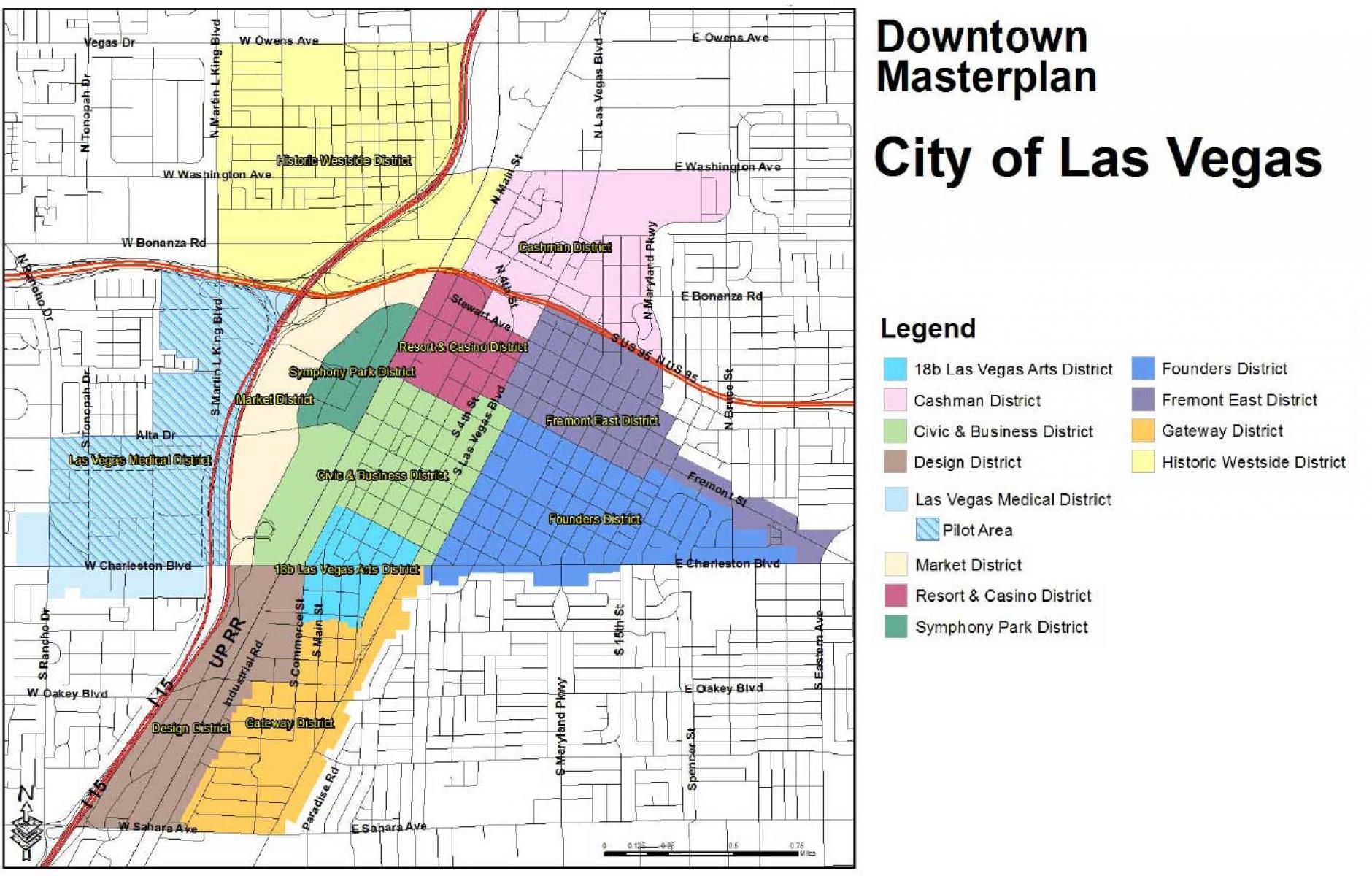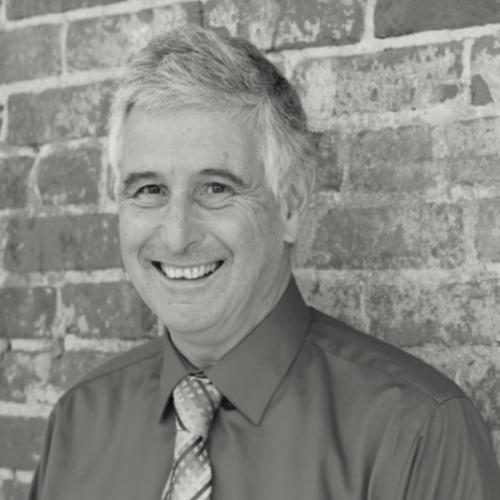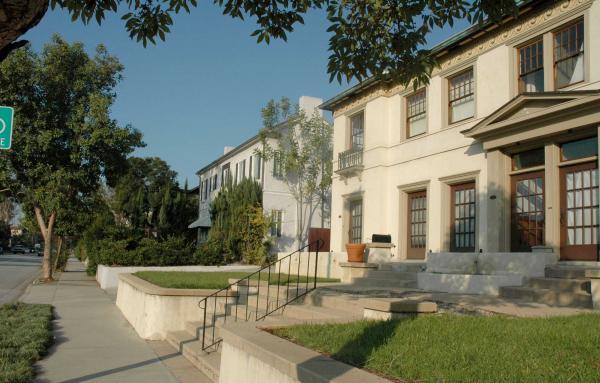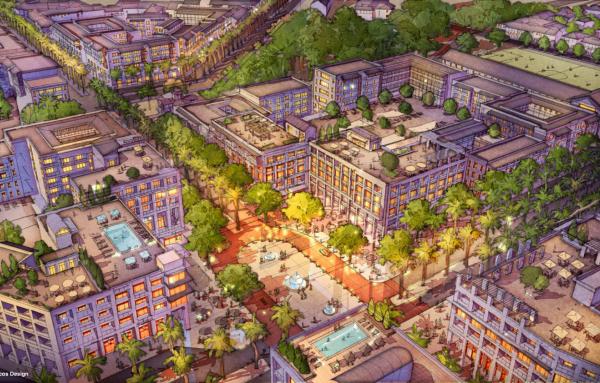
Las Vegas establishes form-based coding in Nevada
Overshadowed by the Las Vegas Strip to the south, Downtown Las Vegas is looking to achieve a more compact, vibrant urban environment with a focus on higher intensity mixed-use development around transit hubs and activity nodes. In an effort to re-energize and support the revitalization of its Downtown, the City adopted the Vision 2045 Downtown Las Vegas Master Plan in July 2016. The Master Plan establishes a framework for a more energetic urban lifestyle and a more attractive and inspiring physical environment. To better anticipate growth and change, the Master Plan encompasses an expanded study area of approximately 2,800 acres and 12 downtown planning districts, including the Las Vegas Medical District, Las Vegas Arts District, Fremont East District, and the Historic Westside District (see plan at top). Each of the districts is unique with a range of demographics, building form, block patterns, development opportunities and character.
The first of 12 implementation actions proposed in the Master Plan is the “adoption [of] a form-based code… that implements the Master Plan through place-based standards.” While some City Planning Department staff had a general idea of a form-based code (FBC), many did not understand how a FBC works, let alone how to implement one. Additionally, the Planning Commission and City Council were unfamiliar with the FBC zoning technique.
In April 2017, the City began working with Lisa Wise Consulting Inc. (LWC) to initiate the Downtown Form-Based Code project and develop a framework for more human-scaled, walkable, mixed-use development as envisioned in the Master Plan.
Given the complex nature of the study area and budget constraints, the greatest challenge was crafting a FBC that embraced the unique characteristics of each district, while providing a comprehensive and consistent range of transects that would apply across all of the downtown areas. To address this challenge, the City established three key priorities:
- Applicability: The FBC needed to be applicable to all 12 districts and organized so it could be integrated into the City’s online zoning code as a new chapter;
- Phased Approach: Over the first 2-3 years of the project, City staff and the consultant would collaborate closely on the first four districts, so that City staff could work independently on FBCs for the remaining districts;
- Education: The City prioritized a sound technical and practical understanding on how FBCs work and the requirements for implementation. The City chose the Form-Based Code Institute’s (FBCI) three-course curriculum as the most effective platform for educating staff, residents, developers, and civic leaders and elected officials on FBCs.
Form-Based Code training
The City hosted five FBCI-curated courses over 18 months which attracted over 100 attendees, many of whom completed all three levels of training. The City planned the course schedule strategically, holding introductory classes soon after the project began to ensure that everyone who works with the FBC would better understand the new coding tool and its process. Attendees included residents, property owners, business owners and operators, planning staff, and local developers eager to understand the mechanics of writing, adopting, and implementing a FBC. Classes also attracted members of the City Council and their staff, Planning Commissioners, local architects, and affordable housing advocates.

“Few understood the possibilities of a form-based code when the City of Las Vegas confronted its downtown vision two years ago,” notes Mike Howe, City of Las Vegas Planning Section Manager/Urban Design Coordinator. “There was hesitation and misunderstanding amid a much-needed change.” The training program was helpful, he says. “The curriculum was tremendously effective for building community buy-in, administrative capacity, and overall competence of our new form-based code.“
The Downtown Las Vegas form-based code
Of the 12 districts in the Master Plan area, the City identified the Las Vegas Medical District as a priority due to development pressure. The Medical District is expected to become the premier medical campus in the southwestern U.S.
After developing a comprehensive outline and structure for Chapter 19.09 (Form-Based Code) of the Las Vegas Unified Development Code, the consultant and the City began developing standards applicable to the Medical District. The team initiated the effort with an analysis of existing built conditions in the Medical District and other downtown districts (i.e., a micro-scale analysis). The results of this analysis informed the standards for building types and frontage types in the FBC. The team also developed transect zones for the FBC, which regulate form and the relationship of buildings to each other and the public realm, rather than a conventional approach, which regulates use. The transect zones are depicted on a zoning map (more precisely a “regulating plan”) and replace the base zones for the district.

The sections and standards of the Downtown Las Vegas FBC applicable to the Medical District were officially adopted on October 19, 2018. The FBC includes development standards and building types that are consistent with and complementary to the University of Nevada Las Vegas medical school, doctors’ offices, and the region’s two large hospitals. The FBC enables a variety of building types and development styles, a wide range of frontage types, and diversity of uses intended to preserve the district’s character while encouraging appropriate development.
City staff leveraged lessons from FBCI classes to participate in the documentation of existing built form, contributed to writing various portions of the FBC, managed the extensive public education and outreach effort to build support for the FBC, and guided the FBC through the extensive public hearing process required to amend the City’s master plan (general plan) and Unified Development Code.
The team recently completed the Public Review Draft of the Fremont East District standards, a mixed-use entertainment hub, which will be presented for adoption in Fall 2019. Thereafter, the team will commence work on the Historic Westside District and the Las Vegas Arts District. Once these are completed, Las Vegas Planning Department staff will complete the FBC for the eight remaining districts.
The City of Las Vegas has taken a bold step to realize its vision for the downtown by updating the Unified Development Code with a FBC. The City will continue to work with LWC on FBCs for the East Fremont, Historic Westside, and Arts Districts, at which time planning staff will take over the process.








